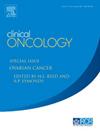Tumour-Specific Growth Rate as a Potential Predictor of Outcomes in Oligoprogressive Disease Treated With Stereotactic Body Radiotherapy
IF 3
3区 医学
Q2 ONCOLOGY
引用次数: 0
Abstract
Aims
Growing data suggest a potential progression-free survival advantage with stereotactic body radiotherapy (SBRT) in oligoprogressive disease (OPD). However, optimal candidates remain uncertain. This study aims to investigate tumour-specific growth rate as a potential predictor of outcomes in OPD.
Materials and Methods
Patients with ≤5 radiological OPDs were enrolled in a prospective phase II study. SBRT-treated metastases were retrospectively contoured on (1) gross tumour volume (GTV)1—pre-SBRT/baseline computed tomography (CT); (2) GTV2—SBRT planning CT, (3) GTV3—post-SBRT follow-up CT. Specific growth rate for each oligoprogressive lesion (SGR_OP) was calculated according to the literature as (ln(GTVy/GTVx)/t) %/d (t = days). SGR_OP1 was defined as pre-SBRT growth (from SBRT planning CT scan to baseline imaging) and SGR_OP2 as post-SBRT growth (from follow-up CT to planning CT). A high SGR_OP1/2 was defined as one greater than the median SGR_OP1/2 value. The primary endpoint was the impact of SGR1/2 on overall survival (OS) rate, which was estimated using the Kaplan-Meier method and Cox proportional hazards models. Local progression (LP) was progression to the treated lesion, while disease progression (DP) was progression of other nontreated metastases. Cumulative incidence function and Fine-Grey subdistribution hazard models were utilised to estimate progression rates.
Results
Thirty-five patients with 55 metastases grouped in gastrointestinal (GI) (40%), genitourinary (GU) (31%), and breast (29%) cancer groups were analysed. The median follow-up was 11.74 months (interquartile range [IQR]: 8.05, 15.65). The median SGR_OP1 and SGR_OP2 value was 0.007 %/d (IQR: 0.004, 0.013) and -0.009 %/d (IQR: -0.014 to 0.002), respectively. Forty-eight percent of patients had high SGR_OP1 (>0.007 %/d). and 50% had high SGR_OP2 (>-0.009 %/d). The 12-month OS rate was 59% (95% confidence interval [CI]: 44.2-78.1), which was significantly lower in the GI group (14% [95% CI: 4-51.5], [P = 0.002]) than in the GU and breast groups. A low SGR_OP1 showed higher rates of OS than high SGR_OP1 (71% vs 47%, P = 0.35).
Conclusion
SGR_OP analysis appears to demonstrate a wide range of growth rates within individual cancer group and may allow prediction of patient outcomes independent of histology. Additional validation will be required to confirm if this tool can be used to predict outcomes.
肿瘤特异性生长速率作为立体定向放射治疗少进展性疾病预后的潜在预测因子
目的:越来越多的数据表明,立体定向体放疗(SBRT)治疗少进展性疾病(OPD)具有潜在的无进展生存优势。然而,最佳人选仍不确定。本研究旨在探讨肿瘤特异性生长速率作为OPD预后的潜在预测因子。材料和方法≤5个影像学opd的患者入组前瞻性II期研究。对经sbrt治疗的转移瘤进行回顾性分析(1)肿瘤总体积(GTV)1 - sbrt前/基线计算机断层扫描(CT);(2) GTV2-SBRT计划CT, (3) gtv3 - sbrt后随访CT。根据文献计算各少进展病灶的特定生长率(SGR_OP)为(ln(GTVy/GTVx)/t) %/d (t = days)。SGR_OP1定义为SBRT前生长(从SBRT计划CT扫描到基线成像),SGR_OP2定义为SBRT后生长(从随访CT到计划CT)。高SGR_OP1/2被定义为大于中位数SGR_OP1/2的值。主要终点是SGR1/2对总生存率(OS)的影响,使用Kaplan-Meier方法和Cox比例风险模型估计。局部进展(LP)是指已治疗病灶的进展,而疾病进展(DP)是指其他未治疗转移灶的进展。累积关联函数和Fine-Grey亚分布风险模型用于估计进展率。结果本组共35例患者55例,分为胃肠道(GI)组(40%)、泌尿生殖系统(GU)组(31%)和乳腺癌组(29%)。中位随访时间为11.74个月(四分位数间距[IQR]: 8.05, 15.65)。SGR_OP1和SGR_OP2的中位值分别为0.007% /d (IQR: 0.004, 0.013)和- 0.009% /d (IQR: -0.014至0.002)。48%的患者SGR_OP1较高(0.007% /d)。50%高SGR_OP2 (>- 0.009% /d)。12个月的OS率为59%(95%可信区间[CI]: 44.2-78.1), GI组的OS率(14% [95% CI: 4-51.5], [P = 0.002])明显低于GU组和乳腺组。低SGR_OP1组的OS发生率高于高SGR_OP1组(71% vs 47%, P = 0.35)。结论sgr_op分析似乎显示了单个癌症组中生长速率的广泛范围,并且可以独立于组织学预测患者预后。需要额外的验证来确认该工具是否可以用于预测结果。
本文章由计算机程序翻译,如有差异,请以英文原文为准。
求助全文
约1分钟内获得全文
求助全文
来源期刊

Clinical oncology
医学-肿瘤学
CiteScore
5.20
自引率
8.80%
发文量
332
审稿时长
40 days
期刊介绍:
Clinical Oncology is an International cancer journal covering all aspects of the clinical management of cancer patients, reflecting a multidisciplinary approach to therapy. Papers, editorials and reviews are published on all types of malignant disease embracing, pathology, diagnosis and treatment, including radiotherapy, chemotherapy, surgery, combined modality treatment and palliative care. Research and review papers covering epidemiology, radiobiology, radiation physics, tumour biology, and immunology are also published, together with letters to the editor, case reports and book reviews.
 求助内容:
求助内容: 应助结果提醒方式:
应助结果提醒方式:


